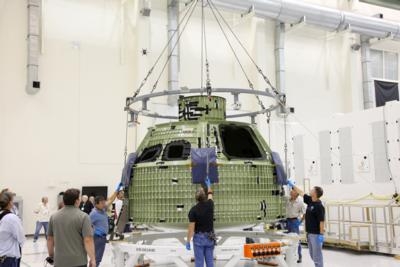Tue, Jul 03, 2012
Agency Takes The Wraps Off First Capsule Destined For Space
The first space-bound Orion capsule has arrived at NASA's Kennedy Space Center in Florida where technicians will turn it into a fully functioning spacecraft ahead of a test flight slated for 2014. The uncrewed flight, called Exploration Flight Test-1 or EFT-1, will be loaded with a wide variety of instruments to evaluate how the spacecraft behaves during launch, in space, and through reentry.

Lori Garver, NASA's deputy administrator, joined a group of officials on Monday to welcome the Orion spacecraft, marking its arrival at Kennedy -- a major milestone in the construction of the vehicle. The space-bound Orion was welded at NASA's Michoud Assembly Facility in New Orleans, in the same factory that built the external tanks for space shuttle missions.
Assembly at Kennedy will take place in the high bay of the Operations and Checkout Building, or O&C. The O&C was refurbished extensively in 2006 and has been outfitted with large fixtures and tools to turn the aluminum shell of Orion into a functioning spacecraft complete with avionics, instrumentation and heat shield.
In 2014, a Delta IV-Heavy rocket from United Launch Alliance will lift the spacecraft into orbit. Its second stage will remain attached to the capsule and will be fired to raise the Orion's orbit to 3,600 miles, about 15 times higher than the International Space Station. The mission will last only a few hours, long enough to make two orbits before being sent plunging back into the atmosphere to test it as deep-space reentry speeds.
Designed with astronauts in mind, Orion will take crews beyond Earth orbit for the first time since 1972, when Apollo 17 completed the last moon landing. The Space Launch System, or SLS -- a gigantic rocket akin to the Saturn V that launched the Apollo spacecraft -- is being developed to launch future Orion missions to deep space. The first launch of the SLS, with Orion atop, is scheduled for 2017.
NASA plans for later Orion spacecraft to take astronauts on missions to destinations far beyond Earth, like an asteroid and Mars.
More News
How To Get A Story On Aero-TV News/Feature Programming How do I submit a story idea or lead to Aero-TV? If you would like to submit a story idea or lead, please contact Jim Campbel>[...]
Aero Linx: International Association of Professional Gyroplane Training (IAPGT) We are an Association of people who fly, build or regulate Gyroplanes, who have a dream of a single >[...]
NORDO (No Radio) Aircraft that cannot or do not communicate by radio when radio communication is required are referred to as “NORDO.”>[...]
Beyond Visual Line Of Sight (BVLOS) The operation of a UAS beyond the visual capability of the flight crew members (i.e., remote pilot in command [RPIC], the person manipulating th>[...]
Aero Linx: Malibu M-Class Owners and Pilots Association (MMOPA) The Piper M-Class Owners & Pilots Association (PMOPA) is a not-for-profit organization dedicated to the interest>[...]
 ANN FAQ: Contributing To Aero-TV
ANN FAQ: Contributing To Aero-TV ANN's Daily Aero-Linx (05.29.24)
ANN's Daily Aero-Linx (05.29.24) ANN's Daily Aero-Term (05.29.24): NORDO (No Radio)
ANN's Daily Aero-Term (05.29.24): NORDO (No Radio) ANN's Daily Aero-Term (05.30.24): Beyond Visual Line Of Sight (BVLOS)
ANN's Daily Aero-Term (05.30.24): Beyond Visual Line Of Sight (BVLOS) ANN's Daily Aero-Linx (05.30.24)
ANN's Daily Aero-Linx (05.30.24)



